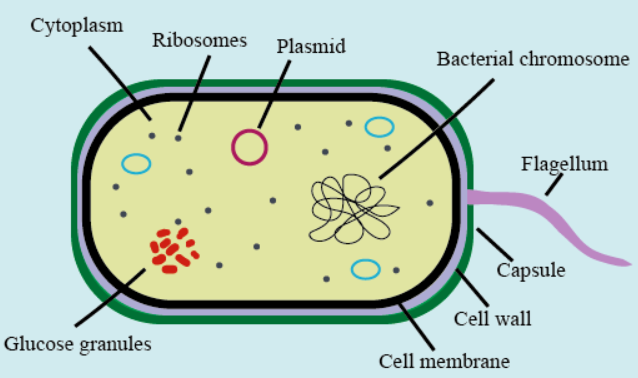
Do bacteria have ER (Endoplasmic Reticulum)?
Answer
440.4k+ views
Hint: Like lysosomes, mitochondria, and Golgi apparatus endoplasmic reticulum is also a membrane-bound organelle and in prokaryotic organisms the membrane-bound organelles are absent.
Complete answer:
No, bacteria do not have endoplasmic reticulum because bacteria is a prokaryotic organism that lacks member bound organelles such as the nucleus, endoplasmic reticulum, mitochondria, lysosomes, Golgi apparatus, etc. Prokaryotes do not have a distinct nucleus but the genetic materials are present in the form of a single circular DNA strand located in the cytoplasm.
-A large domain of prokaryotic microorganisms is constituted by bacteria which are having a number of shapes, ranging from spheres to rods and spirals.
-A cell membrane surrounding the bacterial cell encloses the contents of the cell and acts as a barrier to hold nutrients, like proteins and other essential components of the cytoplasm within the bacterial cell.
-A multi-component cytoskeleton is possessed by bacteria to control the localization of proteins and nucleic acids within the cell and also to manage the process of cell division.
-The general lack of internal membranes in bacteria shows that the reactions, like electron transport, occur across the cell membrane between the cytoplasm and the periplasm the
outside of the cell.
-The cytoplasm is a gel-like material mainly composed of water and it also contains enzymes, salts, cell components, and various organic molecules.
-The ribosome is a cell structure that is responsible for the production of protein.
Nucleoid: This is the area of the cytoplasm that contains the single DNA molecule of cytoplasm.
-Except for the bacteria that belong to genus mycoplasma and thermoplastic the cell wall is present in all the existing bacterias.
-The glycocalyx is found only in some types of prokaryotes; it is a covering made up of glycoprotein-polysaccharide and it surrounds the cell membranes.
Note:
-Bacteriology is a branch of microbiology that deals with the study of bacteria known as bacteriology, a branch of microbiology.
-In bacteria, the cell wall is the outer covering that protects the bacterial cell and is responsible for the definite shape of the bacteria.
-Cytoplasmic inclusions are present in the prokaryotes; these are the inclusion bodies like ribosomes and larger masses that are scattered in the cytoplasmic matrix.

Complete answer:
No, bacteria do not have endoplasmic reticulum because bacteria is a prokaryotic organism that lacks member bound organelles such as the nucleus, endoplasmic reticulum, mitochondria, lysosomes, Golgi apparatus, etc. Prokaryotes do not have a distinct nucleus but the genetic materials are present in the form of a single circular DNA strand located in the cytoplasm.
-A large domain of prokaryotic microorganisms is constituted by bacteria which are having a number of shapes, ranging from spheres to rods and spirals.
-A cell membrane surrounding the bacterial cell encloses the contents of the cell and acts as a barrier to hold nutrients, like proteins and other essential components of the cytoplasm within the bacterial cell.
-A multi-component cytoskeleton is possessed by bacteria to control the localization of proteins and nucleic acids within the cell and also to manage the process of cell division.
-The general lack of internal membranes in bacteria shows that the reactions, like electron transport, occur across the cell membrane between the cytoplasm and the periplasm the
outside of the cell.
-The cytoplasm is a gel-like material mainly composed of water and it also contains enzymes, salts, cell components, and various organic molecules.
-The ribosome is a cell structure that is responsible for the production of protein.
Nucleoid: This is the area of the cytoplasm that contains the single DNA molecule of cytoplasm.
-Except for the bacteria that belong to genus mycoplasma and thermoplastic the cell wall is present in all the existing bacterias.
-The glycocalyx is found only in some types of prokaryotes; it is a covering made up of glycoprotein-polysaccharide and it surrounds the cell membranes.
Note:
-Bacteriology is a branch of microbiology that deals with the study of bacteria known as bacteriology, a branch of microbiology.
-In bacteria, the cell wall is the outer covering that protects the bacterial cell and is responsible for the definite shape of the bacteria.
-Cytoplasmic inclusions are present in the prokaryotes; these are the inclusion bodies like ribosomes and larger masses that are scattered in the cytoplasmic matrix.

Latest Vedantu courses for you
Grade 11 Science PCM | CBSE | SCHOOL | English
CBSE (2025-26)
School Full course for CBSE students
₹41,848 per year
Recently Updated Pages
Express the following as a fraction and simplify a class 7 maths CBSE

The length and width of a rectangle are in ratio of class 7 maths CBSE

The ratio of the income to the expenditure of a family class 7 maths CBSE

How do you write 025 million in scientific notatio class 7 maths CBSE

How do you convert 295 meters per second to kilometers class 7 maths CBSE

Write the following in Roman numerals 25819 class 7 maths CBSE

Trending doubts
State and prove Bernoullis theorem class 11 physics CBSE

What are Quantum numbers Explain the quantum number class 11 chemistry CBSE

Write the differences between monocot plants and dicot class 11 biology CBSE

1 ton equals to A 100 kg B 1000 kg C 10 kg D 10000 class 11 physics CBSE

State the laws of reflection of light

In northern hemisphere 21st March is called as A Vernal class 11 social science CBSE




